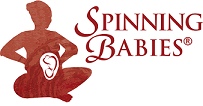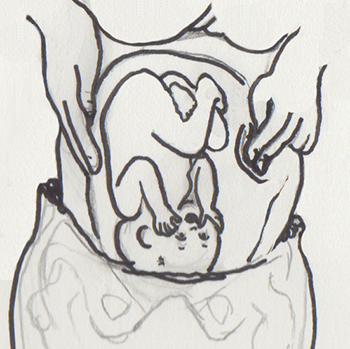What can you expect for your baby’s position at any given week in pregnancy?
Before 24 weeks and sometimes to 28 weeks, the baby is often in the transverse lie. The baby floats in the womb and until the head grows heavy with all those baby thoughts, the baby may not be in a vertical lie (up and down) until 6 or even 7 months. Some of these babies then flip breech but most go head down (cephalic).
Sometime between 26 to 28 weeks most breeches flip head down. When a breech baby first goes head down, they almost always settle down on the mothers right side first.
A common right-sided position for the baby at this stage is called Right Occiput Transverse. In this case, transverse means baby is facing the side since the other word, “occiput” precedes transverse. For some women baby is on the right side only a few days, for others it will be some weeks and maybe their babies never go to the left.
With balance, and the increasing hormones of pregnancy to soften the abdominal muscle fibers, the baby will
settle Left Occiput Transverse or Left Occiput Anterior. Sometimes it takes labor to make this happen these days. Ideally, baby is in their final position for birth by week 34 of pregnancy.
For the mama with a twist in her lower uterine segment or other pelvic torsion, the baby may not switch to the left without daily body balancing activities and sometimes, needing professional body work to make it happen.
These women are untwisting lower uterine torsion, and increasing balance for the womb and pelvic floor. Fetal repositioning to a left-sided presentation can happen when the twist unwinds. Keeping the torsion from returning also may take a few daily activities and good maternal body mechanics.
Few people, even providers, know this path of baby positions. Why? Because:
A.) Fetal position changes are not observable with the eye,
B.) Fetal position changes don’t happen with the same timing or exactly this way for everyone, and
C.) Flexion and Extension are often not considered to be associated with left and right since there are a few exceptions confusing the picture.
People, even providers, think much of fetal position and repositioning is random, that babies are head down only because of gravity and often ignore uterine “balance” which effects shape, except in the extreme cases of bicornate uterus or something on the level of variation that can’t easily be ignored. They aren’t aware of right obliquity, even though it was in the obstetrical literature in the 1800s and before.
Right obliquity is what makes the baby have
a long, straight back and lifted chin aiming the top of the head into the pelvis when on the right
and gives the nice, curved flexion aiming the crown of the head down when on the left.
“Balance” is what allows the uterus the most room for the baby to move to the left. Gravity would encourage baby to settle on the left whenever, and for as long as, there is room is available for baby to rotate. Uterine surges encourage rotation as labor strengthens when there is enough balance for strong contractions to overcome the slight bit of torsion. The first job of labor is to help baby into the pelvis. See more about Engagement in pregnancy or Engagement in Labor at SpinningBabies.com
Come visit the blog. Spinning Babies Blog. www.spinningbabies.com


